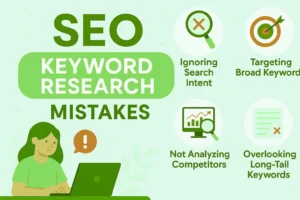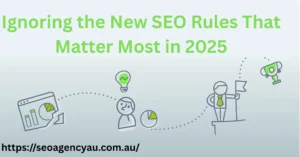You’ve done everything “right”—your website looks modern, your SEO content is live, and you’ve even completed detailed keyword research. Yet… you’re still not ranking on Google.
That feeling of confusion? You’re not alone.
In 2025, search is no longer just about keywords and links. AI-first indexing, semantic relevance, and real-user engagement dominate the rankings now.
🧠 Sometimes it’s not about what you did.
It’s about what you missed.
This guide breaks down the Top 10 Common SEO Mistakes — the ones that quietly sabotage rankings — and shows you how to fix them in an AI-optimized, SGE-friendly, and experience-focused way.
Top 10 Common SEO Mistakes
1. Ignoring the Basics That Still Break SEO in 2025
Even in an AI-powered search world, the basics still matter. Core mistakes like ignoring mobile responsiveness or page speed are still silently hurting your rankings.
Common Oversights:
- Not mobile-friendly
- Slow-loading images
- Writing for bots, not humans
- Not using Google Search Console or Bing Webmaster Tools
Fix it: Run an SEO audit every 30 days using Google Lighthouse or Ahrefs Webmaster Tools. Align with Core Web Vitals and Google’s Page Experience Update. Focus on value, not velocity.
2. SEO Keyword Research Mistakes That Kill Rankings

Choosing high-volume keywords doesn’t guarantee success. If your target keyword doesn’t match search intent, it’s useless.
Example:
You rank for “best laptops” but your audience is searching “best laptops for video editing under $1000.”
Mistakes:
- Ignoring long-tail keywords
- Focusing on volume over intent
- Using outdated keyword tools
Fix it: Use Semrush, AlsoAsked, and Keywords Everywhere. Group keywords by intent: informational, transactional, navigational. Include People Also Ask questions in your content.
3. Expecting to Rank #1 Overnight
In 2025, SEO is compound interest, not instant ROI. Expecting to rank immediately leads to burnout, budget waste, and poor strategy.
Mistakes:
- No KPI alignment
- No timeline for results
- Chasing vanity metrics (e.g., traffic over leads)
Fix it: Set SMART SEO goals:
Specific: Rank for “AI content writing tools for marketers”
Measurable: Get 30 backlinks in 60 days
Achievable: Based on your domain rating
Relevant: Align with business goals
Time-bound: 90-day tracking windows
4. Ignoring On-Page SEO
Your page might look good visually, but if it’s not structured for search engines — you won’t rank.
Common Errors:
- Missing H1s or poor header hierarchy
- No meta titles or descriptions
- Alt tags missing on images
- Keyword stuffing
Fix it: Use Rank Math or Yoast SEO to:
- Structure headings properly
- Write clear, benefit-driven meta descriptions
- Optimize images (size + alt tags)
- Focus on semantic keyword usage, not stuffing
5. The Forgotten Power of Technical SEO
You can’t build skyscrapers on broken foundations. Without strong technical SEO, even the best content stays hidden.
Technical Issues that Break SEO:
Broken internal/external links
- No XML sitemap
- No HTTPS (SSL)
- Improper canonical tags
Fix it: Use Screaming Frog, Sitebulb, or JetOctopus to:
- Identify crawl errors
- Submit sitemap to GSC
- Add HTTPS via Cloudflare or Let’s Encrypt
- Fix orphaned pages and crawl depth issues
6. Ignoring Off-Page SEO & Brand Mentions
SEO is no longer just about your site. Google SGE and AI systems look at your entity reputation — who’s talking about you, linking to you, citing your content.
Off-Page Mistakes:
- No guest posting
- No digital PR
- Ignoring unlinked brand mentions
Fix it:
- Use HARO and Terkel to earn links
- Build topical backlinks from niche-relevant blogs
- Monitor your brand with Google Alerts and Mention
7. Prioritizing Design Over Crawlability
A beautiful website is useless if bots can’t understand it.
Heavy animations, infinite scrolls, or missing heading structure confuse search engines.
Mistakes:
- Using images for headers
- Full-JS pages with no fallback
- No alt text
Fix it:
- Use clean HTML + CSS
- Make sure your core content is crawlable (especially for mobile-first indexing)
- Compress images with TinyPNG and WebP
8. Ignoring SEO Strategy in SaaS Content
SaaS blogs often fail by publishing content no one searches for. They skip bottom-of-funnel intent and product-led SEO.
SaaS SEO Mistakes:
- No onboarding or help doc SEO
- Skipping comparison pages (X vs Y)
- Not linking product pages internally
Fix it:
- Build content clusters:
- “Best CRM for real estate”
- “HubSpot vs Pipedrive for SMBs”
- Link from blogs to product pages naturally
- Include use-case based CTAs, not generic ones
9. Ignoring the New SEO Rules That Matter in 2025

In the age of Search Generative Experience (SGE) and AI Overviews, these are the SEO killers:
What’s Outdated:
- Auto-generated content with no human layer
- Ignoring video SEO
- Bad mobile design
- Over-automated SEO without real value
Fix it:
- Use AI to assist, not automate.
- Add short explainer videos to key content.
- Prioritize mobile UX and tap-target optimization.
- Write for real problems, not just keyword matching.
10. Trying to Fix Everything at Once
SEO isn’t a “fix it and forget it” task. Rushing to solve everything creates chaos, breaks working systems, and confuses Googlebot.
Fix it Properly:
- Audit your site
- Categorize issues (technical, on-page, off-page)
- Prioritize by business impact
- Fix weekly, track in GA4 + GSC
SEO success = Consistency + Prioritization + Time
FAQs about Common SEO Mistakes
What are the common SEO mistakes that beginners should avoid?
Beginners often make simple but costly SEO mistakes.
The most common ones include:
- Targeting the wrong keywords without understanding search intent
- Ignoring on-page SEO fundamentals like meta tags and heading structure
- Skipping mobile optimization and page speed
- Publishing low-quality or duplicated content
- Using outdated tactics like keyword stuffing or poor backlinking
How to avoid them:
Start with the basics—perform keyword research with tools like Semrush, optimize for mobile and UX, and always write for real users, not just search engines.
What are common SEO mistakes that websites make?
Many websites fail to rank due to these recurring issues:
- Missing or duplicated meta tags
- Poor internal linking structure
- Thin content with little topical authority
- Ignoring technical SEO (sitemaps, broken links, redirects)
- Lack of content strategy or topic clusters
Search engines need structure + relevance.
Even visually stunning websites fail if they lack proper indexing, site architecture, and intent-driven content.
What SEO mistakes can destroy your Google rankings?
Some SEO mistakes can severely harm your rankings:
- Publishing AI-generated content without editing
- Ignoring Core Web Vitals and mobile usability
- Using exact-match domains or keyword stuffing
- Poor site architecture or orphan pages
- Ignoring EEAT (Experience, Expertise, Authority, Trust)
These are ranking killers in 2025.
Fix them with SEO audits, human-first content, and aligning with Google’s Helpful Content and Page Experience guidelines.
What’s the biggest SEO mistake beginners make?
The biggest mistake SEO beginners make is expecting fast results.
SEO is not instant. It’s a long-term strategy that builds visibility through consistency and patience.
Other critical mistakes:
- Not tracking results through Google Search Console
- Using generic keywords instead of long-tail, intent-based terms
- Copying competitors without understanding their strategy
Start small. Focus on helpful content, site structure, and user experience. Growth will follow.
What are the top 5 SEO mistakes small businesses make?
Here are five common mistakes of SEO for small businesses should avoid:
- Not setting up or optimizing a Google Business Profile
- Ignoring local SEO keywords and region-specific pages
- Depending only on social media for visibility
- Skipping content marketing and blogging
- Not monitoring performance with SEO tools
For local businesses, visibility = revenue.
Invest in local SEO services, build topical authority, and use data to improve continuously.
What are common mistakes people make in using AI for SEO?
AI tools are powerful but can backfire when misused.
Common mistakes include:
- Publishing AI content without editing for tone, context, or accuracy
- Over-relying on automation for keyword optimization or link-building
- Ignoring EEAT and Helpful Content Guidelines
- Treating AI as a strategy instead of a support tool
Use AI for ideation, not automation.
Combine AI tools with human insight to create original, useful, and search-friendly content.
Final Thoughts: SEO in 2025 is About Layers, Not Hacks
In 2025, SEO is no longer just about being better — it’s about being more relevant, more human, and more structured.
Whether you’re a local business, SaaS startup, or national brand, avoiding these 10 mistakes can transform your traffic, visibility, and authority.
🧠 Remember: You don’t need to fix everything.
Just the right things — at the right time.

